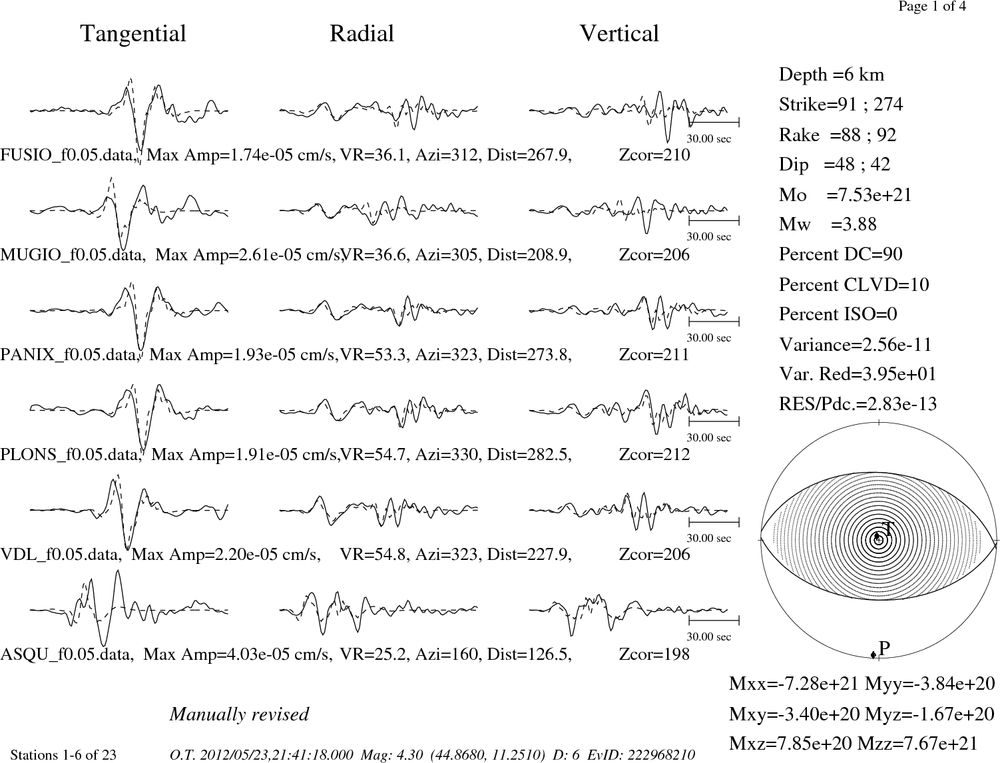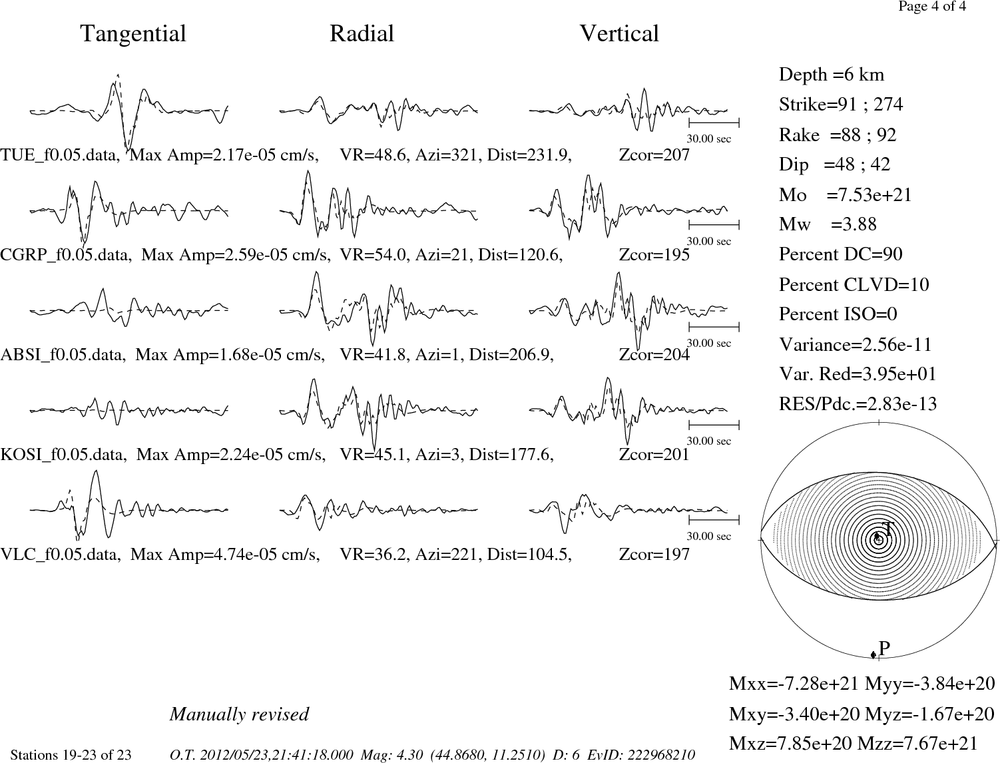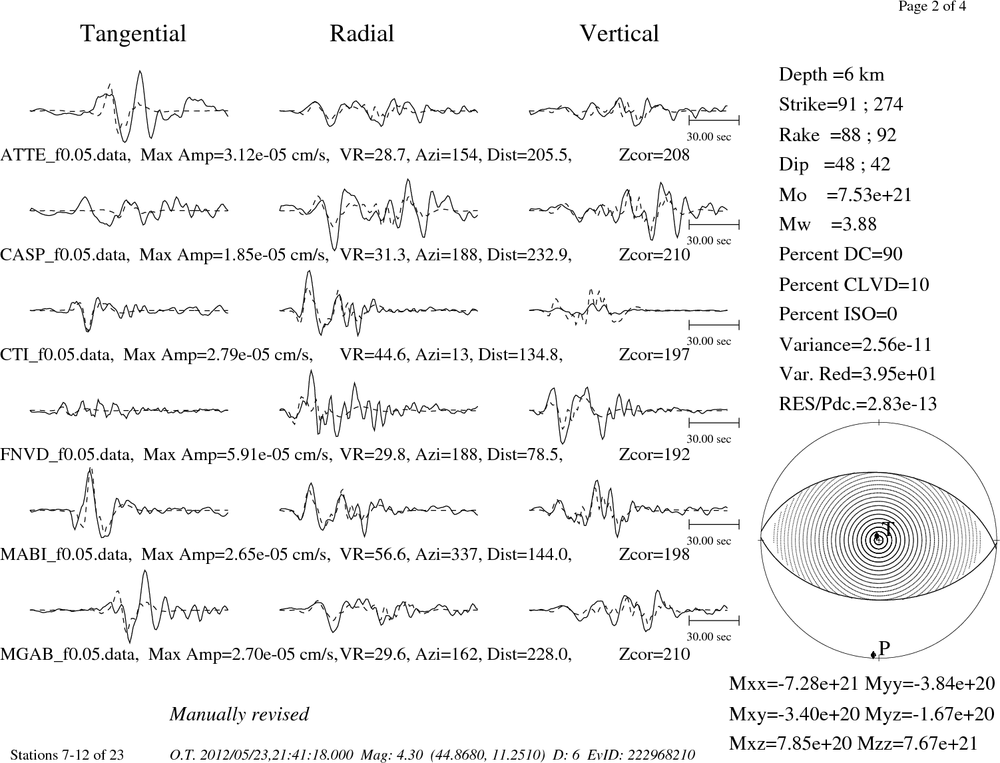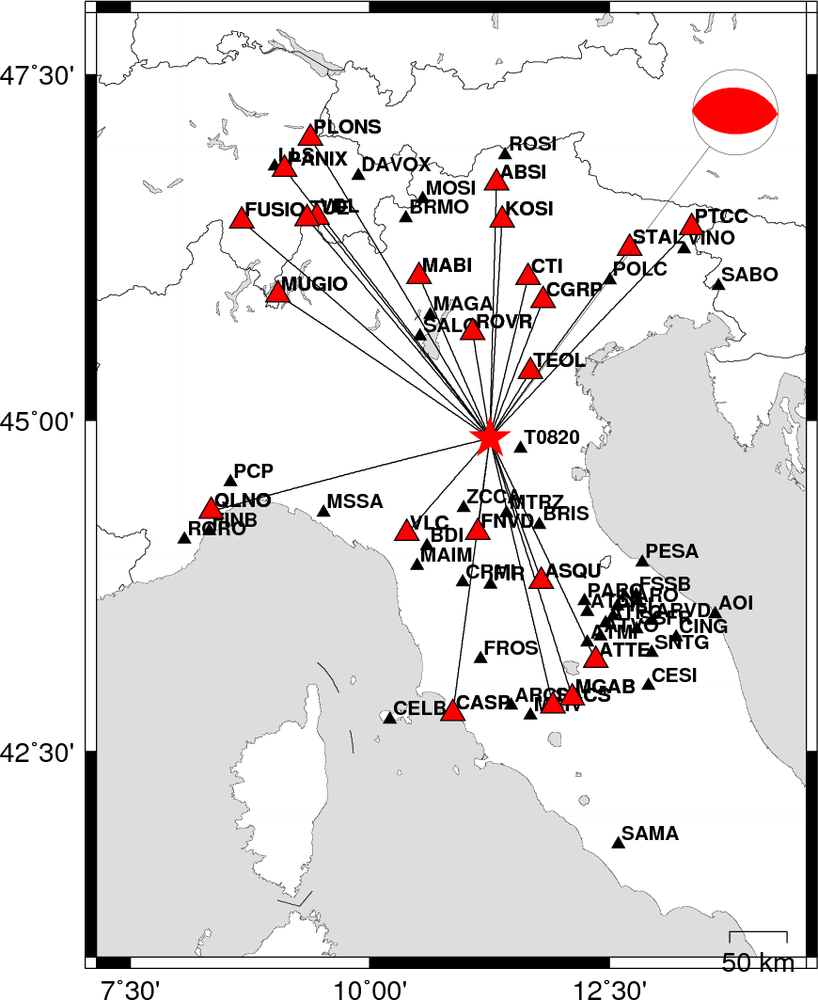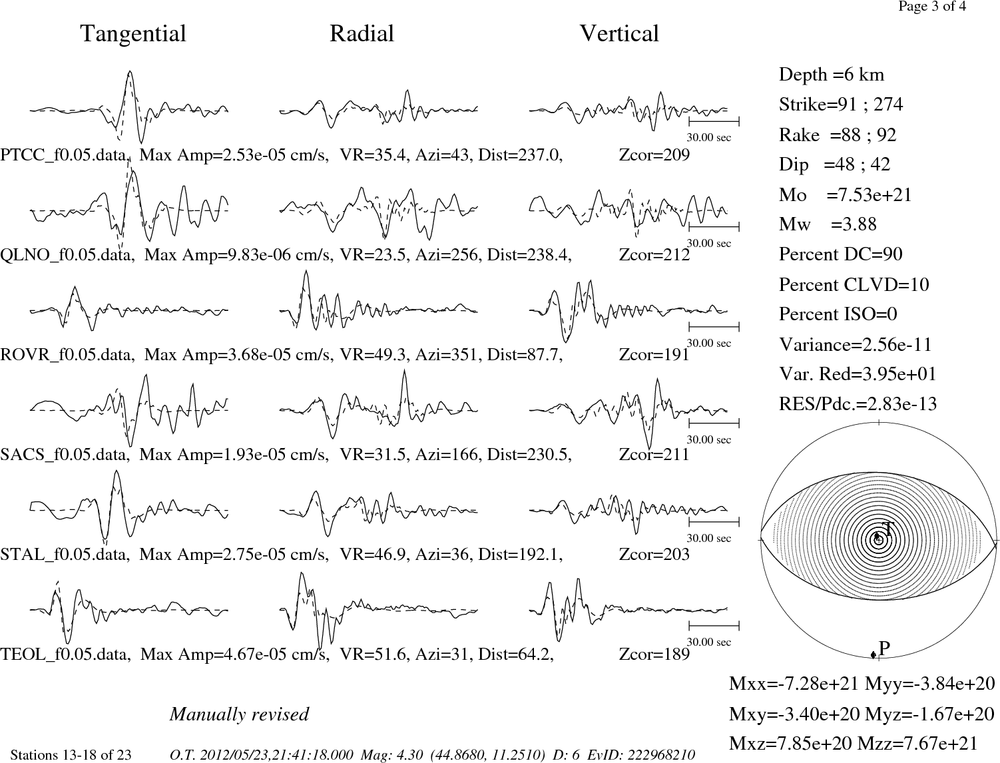Location
2012/05/23 21:41:18 44.868 11.251 4.8 4.3 Italy
Arrival Times (from USGS)
Arrival time list
Felt Map
USGS Felt map for this earthquake
USGS Felt reports page for
Focal Mechanism
SLU Moment Tensor Solution
ENS 2012/05/23 21:41:18:0 44.87 11.25 4.8 4.3 Italy
Stations used:
CH.BNALP CH.PLONS GU.MAIM GU.SATI IV.AOI IV.ARCI IV.ARVD
IV.ASQU IV.ATPC IV.ATTE IV.ATVO IV.BDI IV.BRIS IV.BRMO
IV.CAFI IV.CASP IV.CESI IV.CESX IV.CING IV.CRMI IV.FDMO
IV.FNVD IV.FROS IV.FVI IV.LNSS IV.MABI IV.MCIV IV.MGAB
IV.NRCA IV.PARC IV.PESA IV.PIEI IV.PRMA IV.PTCC IV.QLNO
IV.ROVR IV.SACS IV.SNTG IV.STAL IV.TRIF MN.TUE MN.VLC
NI.AGOR NI.CGRP NI.VINO
Filtering commands used:
hp c 0.02 n 4
lp c 0.05 n 4
Best Fitting Double Couple
Mo = 9.55e+21 dyne-cm
Mw = 3.92
Z = 6 km
Plane Strike Dip Rake
NP1 97 45 95
NP2 270 45 85
Principal Axes:
Axis Value Plunge Azimuth
T 9.55e+21 86 92
N 0.00e+00 4 274
P -9.55e+21 0 184
Moment Tensor: (dyne-cm)
Component Value
Mxx -9.51e+21
Mxy -5.89e+20
Mxz -4.23e+14
Myy -1.40e+13
Myz 5.89e+20
Mzz 9.51e+21
--------------
----------------------
----------------------------
------------------------------
----------------------------------
----------################----------
-------########################-------
-----##############################-----
---##################################---
--######################################--
####################### ###############-
--##################### T ################
---#################### ###############-
----###################################-
------###############################---
--------#########################-----
------------################--------
----------------------------------
------------------------------
----------------------------
-------- -----------
---- P -------
Global CMT Convention Moment Tensor:
R T P
9.51e+21 -4.23e+14 -5.89e+20
-4.23e+14 -9.51e+21 5.89e+20
-5.89e+20 5.89e+20 -1.40e+13
Details of the solution is found at
http://www.eas.slu.edu/eqc/eqc_mt/MECH.IT/20120523214118/index.html
|
Preferred Solution
The preferred solution from an analysis of the surface-wave spectral amplitude radiation pattern, waveform inversion and first motion observations is
STK = 270
DIP = 45
RAKE = 85
MW = 3.92
HS = 6.0
The waveform inversion is preferred.
Moment Tensor Comparison
The following compares this source inversion to others
| SLU |
INGVTDMT |
SLU Moment Tensor Solution
ENS 2012/05/23 21:41:18:0 44.87 11.25 4.8 4.3 Italy
Stations used:
CH.BNALP CH.PLONS GU.MAIM GU.SATI IV.AOI IV.ARCI IV.ARVD
IV.ASQU IV.ATPC IV.ATTE IV.ATVO IV.BDI IV.BRIS IV.BRMO
IV.CAFI IV.CASP IV.CESI IV.CESX IV.CING IV.CRMI IV.FDMO
IV.FNVD IV.FROS IV.FVI IV.LNSS IV.MABI IV.MCIV IV.MGAB
IV.NRCA IV.PARC IV.PESA IV.PIEI IV.PRMA IV.PTCC IV.QLNO
IV.ROVR IV.SACS IV.SNTG IV.STAL IV.TRIF MN.TUE MN.VLC
NI.AGOR NI.CGRP NI.VINO
Filtering commands used:
hp c 0.02 n 4
lp c 0.05 n 4
Best Fitting Double Couple
Mo = 9.55e+21 dyne-cm
Mw = 3.92
Z = 6 km
Plane Strike Dip Rake
NP1 97 45 95
NP2 270 45 85
Principal Axes:
Axis Value Plunge Azimuth
T 9.55e+21 86 92
N 0.00e+00 4 274
P -9.55e+21 0 184
Moment Tensor: (dyne-cm)
Component Value
Mxx -9.51e+21
Mxy -5.89e+20
Mxz -4.23e+14
Myy -1.40e+13
Myz 5.89e+20
Mzz 9.51e+21
--------------
----------------------
----------------------------
------------------------------
----------------------------------
----------################----------
-------########################-------
-----##############################-----
---##################################---
--######################################--
####################### ###############-
--##################### T ################
---#################### ###############-
----###################################-
------###############################---
--------#########################-----
------------################--------
----------------------------------
------------------------------
----------------------------
-------- -----------
---- P -------
Global CMT Convention Moment Tensor:
R T P
9.51e+21 -4.23e+14 -5.89e+20
-4.23e+14 -9.51e+21 5.89e+20
-5.89e+20 5.89e+20 -1.40e+13
Details of the solution is found at
http://www.eas.slu.edu/eqc/eqc_mt/MECH.IT/20120523214118/index.html
|
|
Waveform Inversion
The focal mechanism was determined using broadband seismic waveforms. The location of the event and the
and stations used for the waveform inversion are shown in the next figure.

|
|
Location of broadband stations used for waveform inversion
|
The program wvfgrd96 was used with good traces observed at short distance to determine the focal mechanism, depth and seismic moment. This technique requires a high quality signal and well determined velocity model for the Green functions. To the extent that these are the quality data, this type of mechanism should be preferred over the radiation pattern technique which requires the separate step of defining the pressure and tension quadrants and the correct strike.
The observed and predicted traces are filtered using the following gsac commands:
hp c 0.02 n 4
lp c 0.05 n 4
The results of this grid search from 0.5 to 19 km depth are as follow:
DEPTH STK DIP RAKE MW FIT
WVFGRD96 1.0 235 70 30 3.70 0.4159
WVFGRD96 2.0 240 55 35 3.74 0.4390
WVFGRD96 3.0 250 50 55 3.79 0.4711
WVFGRD96 4.0 265 45 75 3.86 0.5062
WVFGRD96 5.0 270 45 85 3.89 0.5233
WVFGRD96 6.0 270 45 85 3.92 0.5269
WVFGRD96 7.0 270 45 85 3.92 0.4885
WVFGRD96 8.0 245 50 45 3.85 0.4087
WVFGRD96 9.0 235 50 25 3.82 0.3930
WVFGRD96 10.0 225 60 -15 3.79 0.3904
WVFGRD96 11.0 225 60 -20 3.80 0.3934
WVFGRD96 12.0 225 60 -20 3.81 0.3959
WVFGRD96 13.0 225 65 -20 3.81 0.3977
WVFGRD96 14.0 225 65 -20 3.82 0.3997
WVFGRD96 15.0 225 60 -20 3.84 0.3975
WVFGRD96 16.0 225 60 -20 3.84 0.3986
WVFGRD96 17.0 225 65 -20 3.85 0.3992
WVFGRD96 18.0 225 65 -20 3.85 0.3996
WVFGRD96 19.0 225 65 -20 3.86 0.3999
WVFGRD96 20.0 225 65 -20 3.87 0.3997
WVFGRD96 21.0 225 65 -20 3.88 0.3994
WVFGRD96 22.0 225 65 -20 3.88 0.3988
WVFGRD96 23.0 225 65 -20 3.89 0.3980
WVFGRD96 24.0 225 65 -20 3.90 0.3969
WVFGRD96 25.0 225 65 -15 3.91 0.3961
WVFGRD96 26.0 225 65 -15 3.92 0.3950
WVFGRD96 27.0 230 70 -15 3.93 0.3939
WVFGRD96 28.0 230 70 -15 3.94 0.3931
WVFGRD96 29.0 230 70 -15 3.95 0.3920
The best solution is
WVFGRD96 6.0 270 45 85 3.92 0.5269
The mechanism correspond to the best fit is

|
|
Figure 1. Waveform inversion focal mechanism
|
The best fit as a function of depth is given in the following figure:

|
|
Figure 2. Depth sensitivity for waveform mechanism
|
The comparison of the observed and predicted waveforms is given in the next figure. The red traces are the observed and the blue are the predicted.
Each observed-predicted component is plotted to the same scale and peak amplitudes are indicated by the numbers to the left of each trace. A pair of numbers is given in black at the right of each predicted traces. The upper number it the time shift required for maximum correlation between the observed and predicted traces. This time shift is required because the synthetics are not computed at exactly the same distance as the observed and because the velocity model used in the predictions may not be perfect.
A positive time shift indicates that the prediction is too fast and should be delayed to match the observed trace (shift to the right in this figure). A negative value indicates that the prediction is too slow. The lower number gives the percentage of variance reduction to characterize the individual goodness of fit (100% indicates a perfect fit).
The bandpass filter used in the processing and for the display was
hp c 0.02 n 4
lp c 0.05 n 4

|
|
Figure 3. Waveform comparison for selected depth
|

|
|
Focal mechanism sensitivity at the preferred depth. The red color indicates a very good fit to thewavefroms.
Each solution is plotted as a vector at a given value of strike and dip with the angle of the vector representing the rake angle, measured, with respect to the upward vertical (N) in the figure.
|
A check on the assumed source location is possible by looking at the time shifts between the observed and predicted traces. The time shifts for waveform matching arise for several reasons:
- The origin time and epicentral distance are incorrect
- The velocity model used for the inversion is incorrect
- The velocity model used to define the P-arrival time is not the
same as the velocity model used for the waveform inversion
(assuming that the initial trace alignment is based on the
P arrival time)
Assuming only a mislocation, the time shifts are fit to a functional form:
Time_shift = A + B cos Azimuth + C Sin Azimuth
The time shifts for this inversion lead to the next figure:

The derived shift in origin time and epicentral coordinates are given at the bottom of the figure.
Discussion
Velocity Model
The nnCIA used for the waveform synthetic seismograms and for the surface wave eigenfunctions and dispersion is as follows:
MODEL.01
C.It. A. Di Luzio et al Earth Plan Lettrs 280 (2009) 1-12 Fig 5. 7-8 MODEL/SURF3
ISOTROPIC
KGS
FLAT EARTH
1-D
CONSTANT VELOCITY
LINE08
LINE09
LINE10
LINE11
H(KM) VP(KM/S) VS(KM/S) RHO(GM/CC) QP QS ETAP ETAS FREFP FREFS
1.5000 3.7497 2.1436 2.2753 0.500E-02 0.100E-01 0.00 0.00 1.00 1.00
3.0000 4.9399 2.8210 2.4858 0.500E-02 0.100E-01 0.00 0.00 1.00 1.00
3.0000 6.0129 3.4336 2.7058 0.500E-02 0.100E-01 0.00 0.00 1.00 1.00
7.0000 5.5516 3.1475 2.6093 0.167E-02 0.333E-02 0.00 0.00 1.00 1.00
15.0000 5.8805 3.3583 2.6770 0.167E-02 0.333E-02 0.00 0.00 1.00 1.00
6.0000 7.1059 4.0081 3.0002 0.167E-02 0.333E-02 0.00 0.00 1.00 1.00
8.0000 7.1000 3.9864 3.0120 0.167E-02 0.333E-02 0.00 0.00 1.00 1.00
0.0000 7.9000 4.4036 3.2760 0.167E-02 0.333E-02 0.00 0.00 1.00 1.00
Quality Control
Here we tabulate the reasons for not using certain digital data sets
The following stations did not have a valid response files:
DATE=Fri May 25 03:14:08 CDT 2012
Last Changed 2012/05/23
